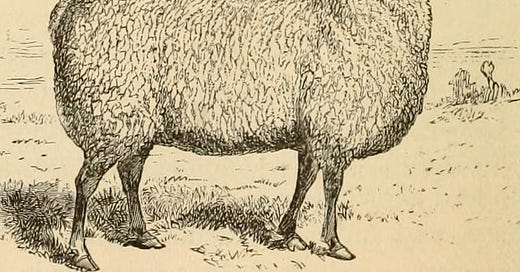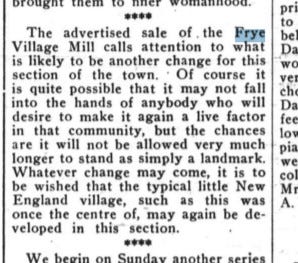Frye Village Stories: Taking a deep dive into General Degreasing (pt1)
A Shawsheen Village 100 Story
Before Shawsheen Village Frye Village Stories: introducing another Frye Village industry, the General Degreasing company
Last week we touched on the process of fulling wool after it was woven. But long before cloth is fulled, the raw wool needed to be “scoured.”
According to one source, raw wool is can be actually up to 85% non-wool. The remaining produce is sweat and grease from the sheep, plus dirt and all other things a sheep comes into contact with. I'll leave that up to your imagination.
After shearing, wool is sorted into similar lengths and quality and then scoured to remove the grease. In a small production, the wool is soaked in hot water with or without a detergent of some kind, rinsed, and then hung or spun to dry. Grease remaining in the water could be turned into lanolin for other uses.
As you can imagine, small production is very different from large scale commercial operations. Major wool manufacturers, like the American Woolen Company, required large amount of raw and scoured wool to be spun and woven into cloth.
Frye Village
After Smith & Dove ceased use of their Frye Village mill site in 1894, the mill buildings were vacant for a number of years. This Sanborn map from the Library of Congress website shows that the Smith & Dove mill buildings were vacant in 1896.
The American and The General Degreasing Companies
November 21, 1902 the Andover Townsman reported that
“Several large pieces of machinery for the American Degreasing company's plant In Frye Village have been received.”
In 1903, the newspaper reported that the degreasing concern was under new ownership by Babcock & Howland, from New York. Mr. Howland intended to live in Andover, while Mr. Babcock would stay in New York.
“The American Degreasing company was organized by Messrs. Babcock and Howland and others to clean wool by the Morse method, a newly invented system.”
Charles E. Howland was the president in 1904.
It was, however, a short-lived venture. Throughout 1906, articles appeared in the Andover Townsman regarding lawsuits files against the General DeGreasing Company for breach of contract and nonpayment of bills.
On this 1906 Sanborn map, American DeGreasing was listed as no longer in operation.
Things did not bode well for the Frye Village degreasing business. June 11, 1909, the property was up for sale.
The situation then developed rapidly over the summer of 1909.
At first, village residents were optimistic that a new industry would move into the site. This appeared in the Andover Townsman "Editorial Cinders" column June 11, 1909.
Alas, a week later, the same column revealed that the property had been purchased by Mr. J.E. McGovern, “the well known horse undertaker of West Andover.”
That could only mean one thing: a fat rendering plant for producing soap. Such a change could slow the pace of development in the village as people moved out of Lawrence into the village.
Editorial Cinders wrote:
“It isn’t good to think what may become of the Frye Village Mill in the light of all the stories that are current regarding the recent sale of it.
Perhaps Mr. McGovern has bought it for the advancement of science or to establish an agricultural school there, or for some other aesthetic use not yet suggested, but current stories would indicate that it is in his mind to use the property for soap making, or some kind of rendering works.
Much as we want to see business come to the town, and the best possible use made of every agent in the town for business, there should be an emphatic and a successful protest uttered at once upon the first appearance of anything of the sort as suggested.
Frye Village is already attractive as many of the residential places located there. It will become more attractive as Lawrence overflows, and not a single thing should be allowed to occur that would injure this growth. No soap works, no rendering plant, no offense of any kind whatsoever should be allowed in any section of residential Andover.”
And then, just a few weeks later, "Trouble Follows Trouble."
The sale of the DeGreasing plant to Mr. McGovern was overseen by receiver William J. Niles of Boston. Niles discovered that personal property had been removed from the site before it was determined if that property was part of the sale:
“...much valuable material has been stolen.
Neighbors gave the information that several loads of material had been carted away at midnight.
The Andover chief of police took hold of the case and found tracks of large wagon wheels which he traced to the house of a well known Andover man. The citizen in question admitted to the receiver that he took the articles at midnight, saying that he knew that they were to be sold at public auction; that he intended to pay for them and he gave the receiver a list of the articles taken.
The value of the property taken is supposed to have been in the neighborhood of $1,000.
No arrests have as yet been made, and the Andover police department claims that it is waiting for word from Receiver Niles.”
The alleged perpetrator's name was never mentioned. One can assume that in a small village, people has an idea about who the supposed guilty party was.
Then, whether by design or by accident, Mr. McGovern seems to have come out ahead in the deal. The next month, in August 1909, he sold the Frye Village property to Frank Binney, representative for William Wood.
There are a few interesting stories behind this that we’ll explore over the next few weeks. The explosive nature of the wool scouring industry is one. The other is the confusing change of hands that occurred over the 7 short years that the “degreasing concern” was located in Frye Village.
Stay tuned!









